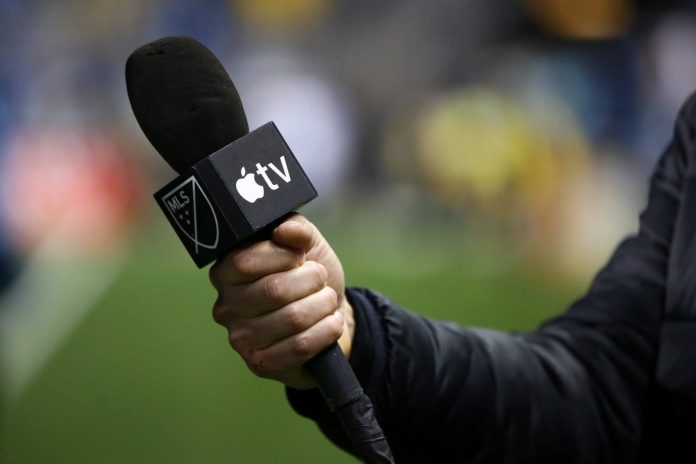Watching live sport on TV has arguably never been more accessible than it is today.
The Premier League is the most-watched sports league in the world and is broadcast in more than 180 countries globally.
Whether you are in the United Kingdom, the United States or Uzbekistan, and just about anywhere else you can think of — except for Russia — you will have the option to watch the biggest teams in football.
But at a time when pockets are being squeezed due to the ongoing cost of living crisis, watching live sport, particularly football, from the comfort of your sofa, could be viewed as a luxury item.
The Athletic has reported on the rising number of people turning to illegal streaming devices, with nearly five million people in the UK alone — nine per cent of the adult population — watching sport via this method in the six months up to October 2025.
In the UK and the U.S., multiple subscriptions are required to access the Premier League, Champions League, Major League Soccer and the major European leagues, and they come at a cost.
“Match tickets, the way travel tickets are priced and all the subscriptions that are required are pushing people to breaking point in many cases,” Tom Greatrex, chairman of the Football Supporters’ Association (FSA), tells The Athletic.
“What has always been a very accessible spectator sport has become, in many cases, prohibitively expensive for people. And not that you would condone it, it is not at all surprising that people will use streaming, despite the fact that it is illegal. They will take that risk because watching sport how you should do is just too expensive for them.
“If things were priced more appropriately, then perhaps it wouldn’t be as big of an issue as it is now.”

(Stu Forster/Getty Images)
The first thing to know about the cost of watching live football in the UK is that it begins with paying for a TV Licence. Paid annually, it costs £174.50 ($231), although you can opt to pay £14.54 ($19) a month.
As part of UK Government legislation, you are required to have a TV Licence if you want to watch or record programmes on a TV as they are broadcast live. Paying the fee also gives you access to the on-demand BBC iPlayer.
It is worth noting that you do not need a TV Licence to stream Netflix, Prime Video and, among other platforms, YouTube through your TV. If you are caught watching live TV without a licence, then you could face a fine of up to £1,000 ($1,314).
Also important to highlight is that the monthly subscription price, whether it is TNT Sports in the UK or Paramount+ in the U.S., unlocks all the live sports content on that particular channel.
So, now that is out of the way and you are already £174.50 down before you’ve even switched on your TV, you won’t be surprised to learn that this is only the first of many payments if you want to consume as much live football as possible in the UK.
Sky Sports is the main broadcaster of Premier League football in the UK, with at least 215 matches screened live in 2025-26 as part of the new domestic TV rights cycle, up from 128 fixtures in 2024-25.
A rolling 31-day subscription to Sky will set you back £25 a month and you’ll need to add the Sky Sports package to access their live sport offering, which is a further £25 a month, totalling £50 ($66). As well as 215 Premier League fixtures, this will also give you access to 33 Bundesliga games a season.
And if you want to consume a further 52 Premier League fixtures over the course of a campaign, then you will need to sign up to TNT Sports, which is currently £30.99 ($41) a month. This means you will need to spend over £80 ($105) a month to consume top-flight football live in the UK.
Sky do offer a Now TV pass, giving you access to Sky Sports for 24 hours, if you only want to watch one day of live sport, costing a one-off payment of £14.99 ($20). A monthly Now TV pass, meanwhile, costs £34.99 ($46).
“I think that the easiest solution, and I know it’s very difficult to implement, is that we almost need to return back to a monopolistic view of sports where it is exclusively through one provider,” Paolo Pescatore, a UK-based media and technology analyst at PP Foresight, tells The Athletic, when asked to reflect on the price it costs to watch football and the rise of illegal streaming.
“But in reality, it’s going to get a lot more fragmented as Amazon spends more, Netflix builds out the architecture to ensure that they can deliver live sports at scale over their networks, and then you have Disney+ and whoever else comes to the table.”

(Carl Recine/Getty Images)
If you only want to watch the highlights from all the Premier League matches at no extra cost to your TV Licence, then you can avoid subscribing to Sky Sports and TNT Sports and tune in to Match of the Day on the BBC, which is aired on Saturday and Sunday nights. Viewers can also watch Champions League highlights on the BBC.
In comparison, NBC Sports in the U.S. own the exclusive rights to all 380 Premier League games a season — made possible by there being no Saturday 3pm blackout as there is in the UK — which will cost Americans $10.99 (£8) a month. The games are shown across the NBC Sports network (NBC, Peacock, USA Network).
There is constant chatter about the Premier League eventually going direct-to-consumer, yet its domestic broadcast deal with Sky Sports and TNT Sports in the UK is worth £1.6billion ($2.1bn) a year, with NBC paying $450million (£342m) a year for the rights.
When it comes to viewing the Champions League in the UK, you will need a TNT Sports subscription, as well as a Prime Video membership.
TNT Sports exclusively broadcasts 187 Champions League fixtures a year in the UK, as well as 189 Europa League ties, with Prime Video — costing £8.99 ($12) a month — having the exclusive rights to 17 games throughout a Champions League tournament.
In the U.S., where you can watch both competitions on CBS, with access to every UEFA match via a Paramount+ subscription, costs $7.99 (£6) a month.
The Paramount+ subscription also includes the ability to screen every Women’s Champions League fixture, too. People in the UK can watch 52 games via Disney+ (£5.99 monthly) and seven on the BBC.
Also available on the BBC are 14 men’s FA Cup fixtures, with 65 men’s and women’s games now being screened on TNT Sports, although some of these are free to air.

(Matt McNulty/Getty Images)
For the MLS this season, viewers in the UK and U.S. will firstly need a subscription to Apple TV’s MLS season-pass, costing £12.99 a month in the UK and $14.99 in the U.S.. This included access to all 510 regular season fixtures as well as all the post-season games.
However, on November 13, Apple announced that, from 2026, MLS will be available without needing to pay an additional fee for the season-pass. NBC and Apple recently unveiled a bundle that combines Apple TV with Peacock for $14.99 (£11) a month, which will give American fans access to the Premier League, MLS and F1 in one place.
The fragmentation of live football is more prevalent when it comes to Italy’s Serie A, Spain’s La Liga, France’s Ligue 1 and Germany’s Bundesliga.
All 380 Serie A games in the UK are available on DAZN, costing £19.99 ($26) for a monthly subscription, with Paramount+ in the U.S. broadcasting over 400 Italian football matches if you include all Suppercoppa Italiana games and at least 25 Coppa Italia fixtures.
Fans of Spanish football in the UK can watch 38 La Liga ties via a Disney+ subscription, but will need to pay for Premier Sports — costing £16.99 ($22) a month — to access the remaining 352 fixtures.
In the U.S., a subscription to ESPN Select, priced at $12.99 (£10) a month, includes all 380 Spanish league fixtures.
Remarkably, the Bundesliga has five different broadcasters in the UK. Prime Video has the rights to 68 matches, Sky Sports can show 33 games, the BBC has the rights to 20 games, while YouTube channels ‘The Overlap’ and ‘That’s Football’ both have access to 20 games. The games on YouTube are aired for free.
ESPN Select has the rights to broadcast more than 300 Bundesliga matches in America.

(LIONEL BONAVENTURE/AFP via Getty Images)
Ligue 1 in France launched its direct-to-consumer streaming service — named Ligue1+ — at the beginning of this season. It costs £9.99 ($13) a month and includes every match. UK-based viewers, however, will be unable to watch any live games during the 3pm blackout window, but can watch them on demand via the streaming service.
Fans of French football in America will need to pay for beIN SPORTS, which will give them access to at least four Ligue 1 games a week. This costs $14.99 (£11) a month and is available via all cable providers or Fubo TV.
The National Women’s Soccer League (NWSL) is the most fragmented competition in America, with matches being broadcast via CBS Sports, ESPN, Prime Video, ION and NWSL+, whereas in the UK all NWSL+ games are available for free via the NWSL+ platform.
England’s Women’s Super League (WSL) is screened by three different providers: Sky Sports, the BBC and the WSL’s YouTube channel.
ESPN has the rights to 57 WSL games in the U.S., with American fans also being able to watch matches via the league’s YouTube channel.
The U.S. national teams can be watched on Turner Sports, TNT via HBO Max Stream — costing $10.99 (£8) a month — and Peacock.

(James Fearn/Getty Images)
With illegal streaming on the rise, Greatrix believes it would be “appropriate, rational and sensible” for the price it costs to watch live football at home to be looked at again to ensure that it becomes “less of a temptation” for people to do so illegally.
But the costs broadcasters are paying to secure live rights are on an upward curve, and the one way they make their money back is through charging a monthly subscription and advertising.
Interestingly, Pescatore believes, at least in the UK, the subscription model, as far as top-flight football is concerned, has plateaued.
“There probably aren’t any more subscribers to gain just because of the Premier League,” he says. “There is another argument in that why force people to sign up to a bundle as part of a TV service when you can just completely decouple it altogether?
“Maybe that’s one avenue to go down, which would give you a lot more flexibility in terms of choosing which live sport you want to watch and pay for instead of paying for access to multiple sports.”
No matter how it is dressed up, the fact that more people are turning to illegal streams is rightly a cause for concern for the leagues and broadcasters — yet the fragmented nature of live sport and the price it costs to watch it is clearly a concern for those choosing to watch it illegally.
And it is not only a debate that will continue to rumble on, you suspect the illegal streamers are going to become more entrenched as the fragmented nature of live sport, coupled with a cost of living crisis, makes it harder for people to pay to watch.
Additional reporting: Melanie Anzidei







